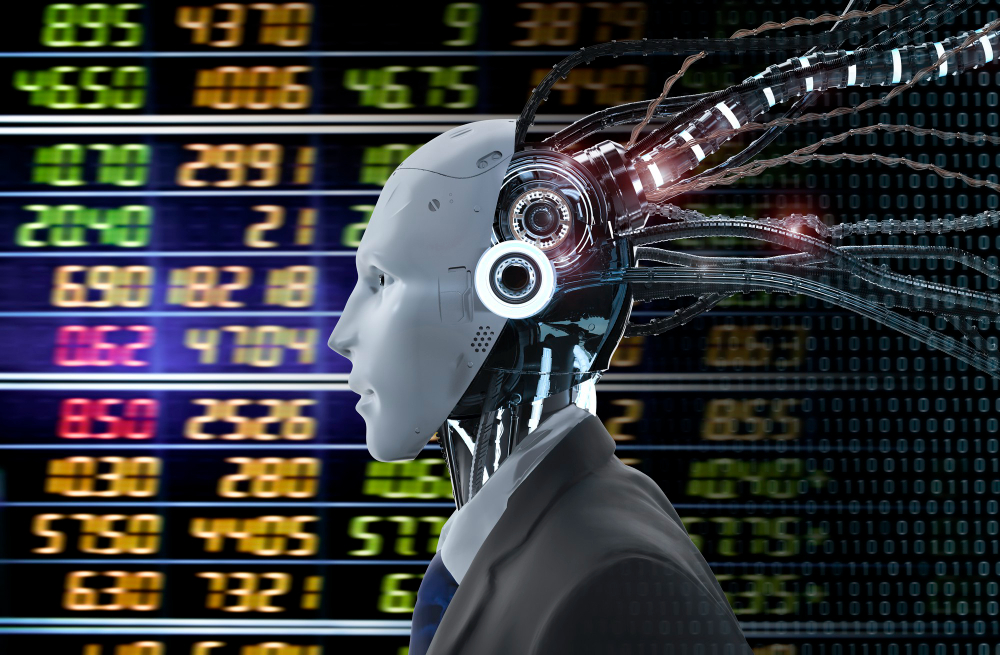Machine learning (ML) has rapidly transformed the financial world, offering traders and investors advanced tools for predicting stock market trends. By leveraging large datasets and sophisticated algorithms, machine learning enables more accurate forecasting, allowing investors to make better-informed decisions.
From identifying patterns in historical stock prices to recognizing shifts in market sentiment, machine learning is playing an increasingly critical role in modern finance. In this article, we’ll explore how machine learning algorithms are used to predict stock market trends, the benefits and challenges they bring, and their potential future impact on trading.
What Is Machine Learning in Finance?
Machine learning is a subset of artificial intelligence (AI) that focuses on developing algorithms that allow computers to learn from and make predictions based on data. In the context of stock market predictions, machine learning algorithms analyze historical data, including stock prices, trading volumes, news sentiment, and other relevant factors, to identify patterns and trends that may indicate future market movements.
Unlike traditional models, which rely on predefined rules, machine learning models can adapt over time, improving their accuracy as they process more data. This ability to “learn” from data without being explicitly programmed makes machine learning a powerful tool for stock market analysis.
Types of Machine Learning Algorithms Used in Stock Market Prediction
Several types of machine learning algorithms are commonly used to predict stock market trends. Each approach has its own strengths and is suited for different types of data analysis and forecasting.
- Supervised Learning
In supervised learning, the algorithm is trained on historical data that includes both input variables (such as stock prices, economic indicators, etc.) and the desired output (future stock prices or trends). The algorithm “learns” from this data to predict future stock prices based on new inputs.
- Example: Linear regression, one of the simplest forms of supervised learning, can be used to predict stock prices based on historical price trends. More complex algorithms like support vector machines (SVMs) or decision trees can also be used to predict stock price movements.
- Unsupervised Learning
Unsupervised learning algorithms work with data that does not include predefined labels or outputs. These algorithms try to identify hidden patterns or groupings within the data. In the stock market, unsupervised learning can be used to identify clusters of stocks that behave similarly under certain market conditions.
- Example: K-means clustering, an unsupervised learning algorithm, can be used to group stocks based on price movements or other characteristics, helping traders identify which stocks are likely to react similarly to market shifts.
- Reinforcement Learning
Reinforcement learning involves training an algorithm to make decisions by rewarding or punishing certain actions based on their outcomes. This method is particularly useful for trading algorithms, where the goal is to maximize profits by learning from previous trades.
- Example: An algorithm could be trained to buy, sell, or hold a stock based on market conditions, with the objective of maximizing returns. The algorithm learns over time which actions tend to result in profits and adjusts its strategy accordingly.

How Machine Learning Predicts Stock Market Trends
- Pattern Recognition and Anomaly Detection
One of the primary uses of machine learning in stock market prediction is pattern recognition. Machine learning algorithms can process massive amounts of historical data and identify recurring patterns that have historically preceded stock market movements. These patterns may be based on price trends, trading volume, or technical indicators like moving averages.
For example, if an algorithm identifies a pattern where a certain stock consistently rises after a particular set of conditions, it can suggest buying that stock when those conditions are met in the future.
In addition to pattern recognition, machine learning is also highly effective in anomaly detection. It can flag unusual price movements or trading volumes that may signal a potential market correction or opportunity, allowing traders to act quickly.
- Sentiment Analysis
Machine learning algorithms are increasingly being used to perform sentiment analysis, which involves analyzing news articles, social media posts, and financial reports to gauge market sentiment. Positive or negative sentiment about a stock, sector, or the overall market can often precede price movements.
Natural language processing (NLP) is a branch of machine learning that allows algorithms to understand and analyze text-based data. For example, NLP algorithms can scan thousands of news articles and social media posts to determine if the sentiment around a particular stock is positive or negative, which can help traders make more informed decisions.
- Predictive Analytics
By analyzing historical market data, machine learning algorithms can make predictions about future stock price movements. These predictions are often based on statistical models that take into account various factors, such as historical price trends, macroeconomic indicators, trading volumes, and corporate earnings reports.
Machine learning algorithms can also adapt to new data, improving their accuracy over time. This adaptability is particularly valuable in dynamic markets where conditions change rapidly.
- Algorithmic Trading
Machine learning is a cornerstone of algorithmic trading, where algorithms automatically execute trades based on predefined criteria. These algorithms can use machine learning models to predict short-term price movements and execute trades with minimal human intervention. High-frequency trading (HFT) is one example where machine learning plays a crucial role in executing thousands of trades in milliseconds, capitalizing on tiny price differences.
Benefits of Using Machine Learning for Stock Market Prediction
- Data Processing Power
One of the biggest advantages of machine learning is its ability to process and analyze vast amounts of data quickly. Stock markets generate massive volumes of data every second, and machine learning algorithms can sift through this information to identify patterns and trends that would be impossible for human traders to detect.
- Improved Accuracy
Machine learning algorithms improve their accuracy over time as they are exposed to more data. As a result, they can make better predictions as market conditions evolve, reducing the likelihood of poor trading decisions based on outdated or incomplete information.
- Automation
Machine learning allows for the automation of many aspects of trading, from analyzing market data to executing trades. This can save traders time and effort while also eliminating emotional biases that often lead to poor investment decisions.
- Risk Management
Machine learning can also be used to manage risk more effectively. By continuously monitoring market conditions and analyzing historical data, machine learning models can identify potential risks before they materialize, allowing traders to adjust their strategies accordingly.
Challenges and Limitations of Machine Learning in Stock Prediction
- Market Uncertainty
Despite its predictive power, machine learning is not foolproof. The stock market is influenced by countless factors, many of which are unpredictable, such as geopolitical events, natural disasters, or sudden corporate scandals. These unpredictable events can disrupt even the most sophisticated machine learning models.
- Overfitting
Overfitting occurs when a machine learning model becomes too specialized, meaning it performs exceptionally well on historical data but poorly on new, unseen data. This can be a major problem for stock market prediction models, as they may incorrectly assume that past trends will continue indefinitely.
- Data Quality
The accuracy of machine learning models depends heavily on the quality of the data they are trained on. Incomplete or inaccurate data can lead to poor predictions, potentially resulting in financial losses.
- Regulatory and Ethical Concerns
As machine learning becomes more prevalent in trading, regulatory and ethical concerns arise. High-frequency trading driven by machine learning algorithms can contribute to market volatility, and there are questions about fairness and transparency in markets where sophisticated algorithms have a significant advantage over retail investors.
The Future of Machine Learning in Stock Market Prediction
Machine learning is expected to play an increasingly important role in stock market trading as algorithms become more advanced and capable of processing even larger datasets in real-time. With advancements in areas such as quantum computing and AI, machine learning could revolutionize stock market prediction, providing even more accurate forecasts and opening up new possibilities for algorithmic trading.
In the long run, we may see more democratization of machine learning tools, allowing retail investors to access the same predictive capabilities currently available to large financial institutions. However, as the technology evolves, it will be important to address the challenges of data quality, overfitting, and ethical concerns to ensure that machine learning is used responsibly.
Conclusion
Machine learning has revolutionized stock market prediction by providing traders with powerful tools to analyze vast amounts of data, identify patterns, and make more accurate forecasts. From predictive analytics to sentiment analysis, machine learning is becoming an integral part of modern trading strategies.
While challenges such as market uncertainty and data quality remain, the potential for machine learning to reshape the financial markets is undeniable. As the technology continues to evolve, it is likely to play an even more significant role in the future of stock market prediction and trading.
Revolutionize your portfolio on MuxCap’s platform.
- What Is Machine Learning in Finance?
- Types of Machine Learning Algorithms Used in Stock Market Prediction
- How Machine Learning Predicts Stock Market Trends
- Benefits of Using Machine Learning for Stock Market Prediction
- Challenges and Limitations of Machine Learning in Stock Prediction
- The Future of Machine Learning in Stock Market Prediction
- Conclusion
Popular Posts
- Understanding Stock Market Indicators: Key Metrics for Successful Trading and Investment

- Exploring the World of Crypto Futures and Options: Strategies & Risks

- How Leverage Works in Forex and Futures Markets: Opportunities and Pitfalls

- Algorithmic Trading in the Stock Market: The Future of Automated Investing


























